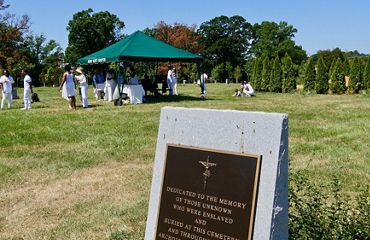Celebrating Family: The Happiest Hour
A community-designed greenspace provides the setting for a family to reflect on the legacy of their enslaved ancestors.
On a particularly bright Sunday in August, descendants of freedmen John and Arabella Weems gathered at Washington, D.C.'s historic Mount Olivet Cemetery to reflect on the legacy of their once enslaved ancestors and rejoice in the new family connections they had made.
The gathering was part of a full weekend of events organized by Gayle George, a local writer and publisher, to make the story of John and Arabella Weems come alive for attendees.
Quote: Gayle George

If you carry a name and you don’t know anybody in your family—what does that mean? To be able to connect with the story and other people that are descendants is a powerful thing.
Arabella and John Weems’ determination to escape captivity and ensure that each of their children was freed raised public awareness at the time to the plight of fugitive slave families. Their efforts galvanized the financial and moral support of an international community of abolitionists committed to ensuring the family’s freedom, and forged a loose network of anti-slavery sympathizers into an efficient leg of the Underground Railroad between Washington, D.C., and Ontario, Canada.
Despite the notoriety they gained and their incredible success in finally becoming free, John and Arabella Weems were laid to rest in the large area of Mt. Olivet containing many unmarked graves—including those of enslaved people. That same area was memorialized with a Community-Designed Greenspace (CDG) spearheaded by TNC and Nature Sacred, a project intended to acknowledge those buried at the site while providing a space for visitors to reflect in nature.
The August gathering was the first intentional convening of all known family members from Canada and around the United States, five generations after John and Arabella, so Gayle dubbed it “the happiest hour.”
As attendees tied prayer ribbons to trees, Gayle spoke about what the weekend and the new green space meant to her.
"I began doing some research after the documentary Railroad Ties came out. It revealed some names of our ancestors in the DC [area] dating back to the 1800s. I found out that John and Arabella Weems are buried here at Mt. Olivet in unmarked graves. To me, that didn’t feel right. I felt like they should be acknowledged in some kind of way. And so, I started working on a way to acknowledge them."
Quote: Gayle George
This is a place that acknowledges those people that are buried here. And we know that our ancestors are buried here. I call it a sacred space.

"The whole weekend became about making connections with other descendants and learning the history, really. Having a deeper appreciation of the experience of the Weems, and what their journey was to liberation. And also finding each other. People may have had certain names or surnames but didn’t really know how they connected to the story and to each other, so we’ve been able to build out this massive tree and link our family history through six, seven generations in D.C.
"The event was meant to create these experiences and opportunities to interact. Not scripted or really formalized, but to see what unfolds, because there’s a lot of emotions and reconciliation that’s happening. Even within yourself. If you carry a name and you don’t know anybody in your family—what does that mean? To be able to connect with the story and other people that are descendants is a powerful thing. It’s something you can’t script or put a shape around. You just create the space for it and allow for whatever the experience will be to come forward.
"Initially, the idea of us getting together was going to be to lay stones on our ancestors’ graves. This [memorial green space] kind of serves as a surrogate for that... This is a place that acknowledges those people that are buried here. And we know that our ancestors are buried here. I call it a sacred space."
Visit this Historic Cemetery
-

Mount Olivet Cemetery
Mount Olivet Cemetery welcomes visitors to respectfully enjoy its grounds, its history and its myriad conservation projects, many of which include TNC as a partner. Learn More
We Can’t Save Nature Without You
Sign up to receive monthly conservation news and updates from Maryland/DC. Get a preview of Maryland/DC's Nature News email.





